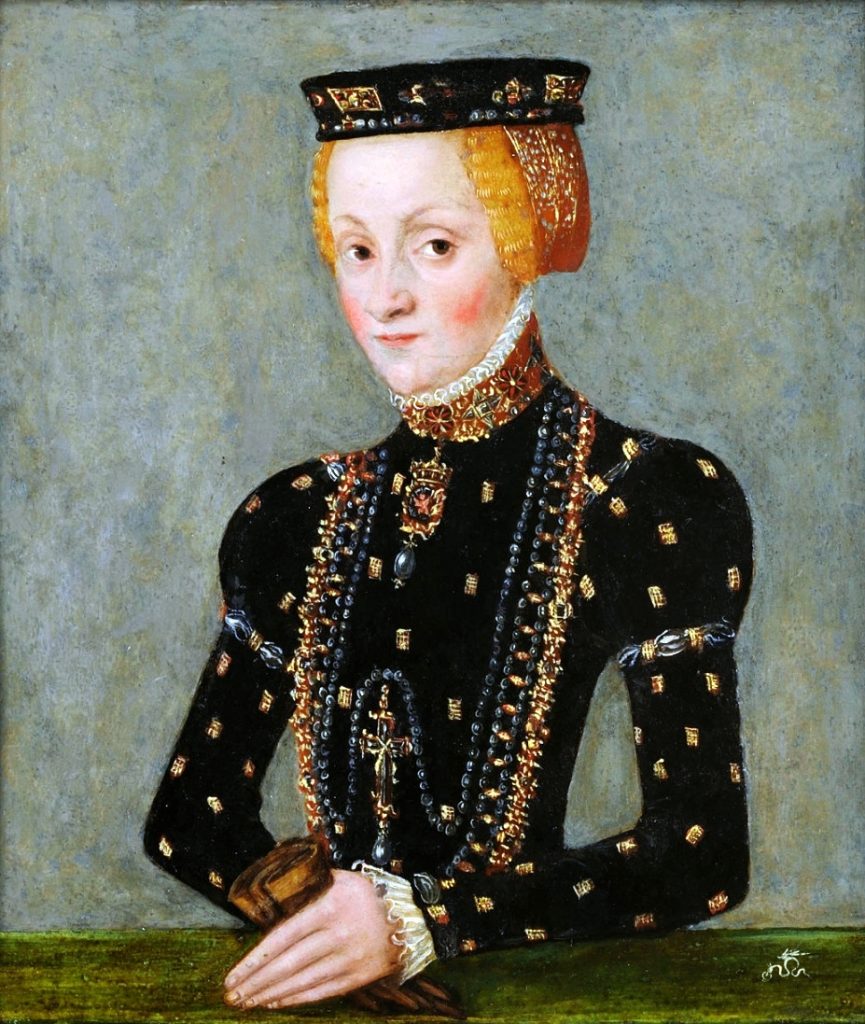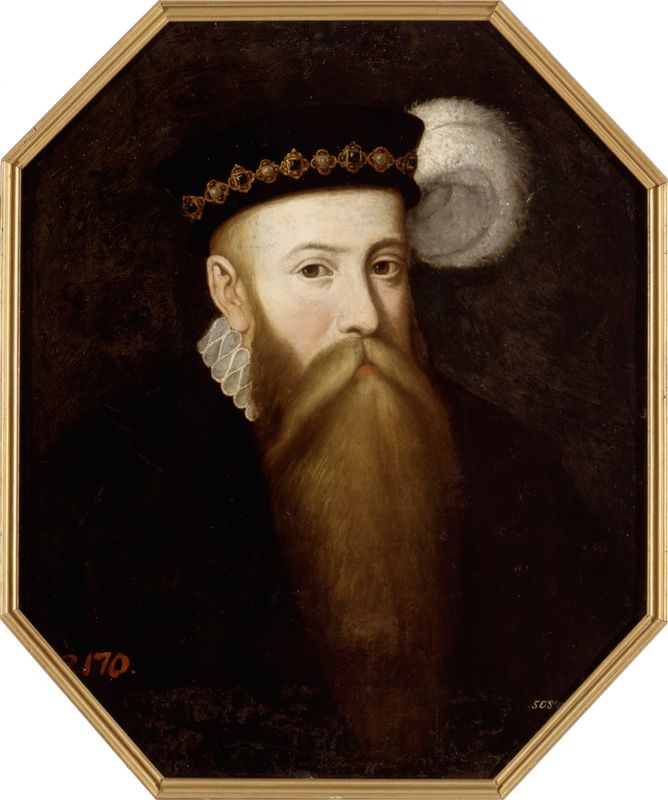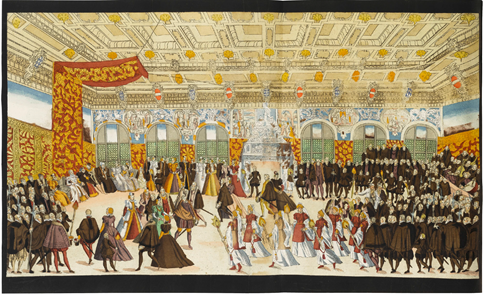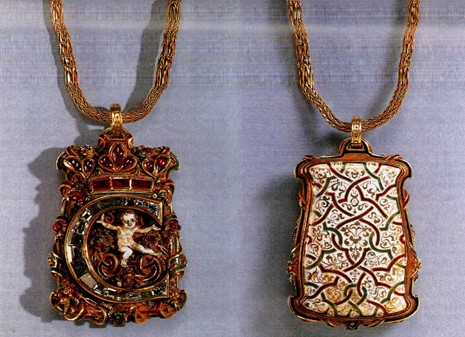“Nothing but Death”: A Royal Wedding in Vilnius
“
In Vilnius, Catherine and John exchanged rings engraved with words Nemo nisi mors (Nothing but death). They vowed to share every moment of happiness and misfortune, but certainly could not imagine then just how many daunting events awaited them. Regardless of years-long imprisonment and life-threatening events, honored the wedding vows given in Vilnius.
In early October 1562 Vilnius witnessed a pompous marriage ceremony of Catherine Jagiellon (1526–1583) and John III Vasa (1537–1592). The marriage was considered an important political endeavour, because John was the Duke of Finland, while his wife was the sister of King of Poland and Grand Duke of Lithuania Sigismund II Augustus.
In spite of the long-standing practice, the groom travelled to a foreign country instead of arranging a celebration in his own. The marriage in Vilnius was all the more exceptional because all 16th century queens of Poland and grand duchesses of Lithuania celebrated their weddings in Kraków, except for Barbara Radziwiłł and Anna Jagiellon.
In Vilnius, Catherine and John exchanged rings engraved with words Nemo nisi mors (Nothing but death). They vowed to share every moment of happiness and misfortune, but certainly could not imagine then just how many daunting events awaited them. Regardless of years-long imprisonment and life-threatening events, honored the wedding vows given in Vilnius.
A political union
As it was customary back then, a royal marriage was a political decision and the union of the houses of Jagiellon and Vasa aimed at resolving a conflict regarding Livonia. In the middle of the 16th century Lithuania, Poland, Muscovy, Scandinavian nations, Prussia, and the Holy Roman Empire competed for domination in Livonia.
Sigismund Augustus wanted to marry off his two sisters, Anna and Catherine, to gain an advantage. Anne agreed that Catherine, the younger of the two, was married first. She was famed as a beautiful woman and historians dubbed her the New Helena.
Do You Know?
Both Sweden and Muscovy sought to take advantage of marrying Catherine. Negotiations regarding her spouse took place in Vilnius, where she lived from 1556 to 1562. Tsar Ivan the Terrible of Muscovy, whose first wife died in 1560, sent an official delegation to Vilnius in September of the same year. Fortunately for Catherine, the talks came to naught due to political reasons. In the spring of 1561, with Muscovy fighting in Livonia again, Sweden stepped forward.
A large part of Livonia became an autonomous province of the Grand Duchy of Lithuania, therefore by marrying Catherine Jagiellon, Duke of Finland John III Vasa (whose brother was the king of Sweden) would have solidified his political presence in Livonia.
Talks in Kaunas, bride in Vilnius
“
Duke John III Vasa was accompanied by 120 horsemen, twelve drabants (or bodyguards), seven trumpeters, a drummer, and four pages. They rode to the Town Hall Square and were offered accommodation in nearby homes.
Only during a second round of talks an agreement was reached, although John III Vasa had already lent Sigismund Augustus a substantial amount of money following their first agreement. Initially the King of Sweden opposed the alliance, but in 1562 Duke John arrived in Lithuania for the second time with an even larger loan on offer.
Sigismund Augustus, escorted by guards and courtiers, met the guest near Kaunas, on a meadow by Neris. Duke John III Vasa was accompanied by 120 horsemen, twelve drabants (or bodyguards), seven trumpeters, a drummer, and four pages. They rode to the Town Hall Square and were offered accommodation in nearby homes.
The negotiations lasted for two days and were finalized by exchanging gifts. Sigismund Augustus then went to Vilnius to ask Catherine’s opinion and once she agreed to become the wife of the duke of Finland, the nuptials were set for 4 October 1562.
From the Lower Castle to the cathedral
Festive events in Vilnius began two days prior to the wedding on 2 October 1562. They entertained many local residents and drew in hundreds of prominent guests, Polish and Lithuanian magnates in particular. The Duke of Prussia with his cohort also took part in the week-long celebration arranged in accordance with European royal tradition.
On October 2, John III Vasa entered Vilnius. Sigismund Augustus welcomed the groom just outside the city walls, accompanied by as many as 6,000 beautifully dressed horsemen. The groom’ suite comprised 300 mounted guards. After having exchanged solemn greetings, the delegations rode to the Lower Castle, where on 3 October a marriage contract was signed.
“
The official part in a church usually was long and exhausting. During the wedding of Sigismund Augustus and Elisabeth of Austria in 1543, her new father-in-law, King Sigismund the Old, suggested on several occasions that she should “take the crown off, if it is too heavy, and put it aside”.
The official part in a church usually was long and exhausting. During the wedding of Sigismund Augustus and Elisabeth of Austria in 1543, her new father-in-law, King Sigismund the Old, suggested on several occasions that she should “take the crown off, if it is too heavy, and put it aside”.
The nuptials of John and Catherine took place in Vilnius Cathedral, the service there led by the Bishop of Vilnius, Walerian Protasewicz.
After the ceremony, everybody returned to the castle, where, according to the envoy of Florence, “the most luxurious banquet was arranged”. The groom “had fun all day, and in the evening was given his wife”. According to another witness, John and Catherine were offered the best rooms available. But another ritual awaited them at their bedside, where a high-ranking Polish official gave a long speech in Latin, to which the groom had to respond in “ornate Latin words”.
In addition to the Latin-speaking nobleman, the couple also found in their bedroom a table served with delicacies, including sugar coated marzipans, cinnamon cakes, and wine.
Vilnius in festive mood
Before, during, and after the wedding city was going crazy. According to the contemporaries, “dances, races, German and hussar tournaments lasted for the whole week and there was music and all kinds of decent entertainment”. Tournaments featured such hard clashes that the fighters injured themselves and occasionally killed their mounts.
“
On 8 October the dowry of Catherine Jagiellon, now the Duchess of Finland, was inventoried. Her jewels alone were worth more than 100,000 thalers. The dowry also included silver, clothing, horses and carriages. In exchange, the Duke of Finland gave her the Abo prefecture, generating 3,000 zlotys in annual income, and landed property.
On 8 October the dowry of Catherine Jagiellon, now the Duchess of Finland, was inventoried. Her jewels alone were worth more than 100,000 thalers. The dowry also included silver, clothing, horses and carriages. In exchange, the Duke of Finland gave her the Abo prefecture, generating 3,000 zlotys in annual income, and landed property.
After a busy week of celebration in Vilnius, the couple left for Finland. Sigismund Augustus accompanied the newlyweds and dined with them in a tent built outside the city. According to the witnesses, the final farewell of the brother and sister was tearful.
Catherine, then 36, married a man eleven years her junior, but their life was happy. The four years they spent as prisoners in Gripsholm Castle in Sweden strengthened their emotional bond. Later John confessed to the papal envoy that he had been faithful to Catherine throughout their marriage. In 1576 he gave her a present, the palace of Drottningholm (or Queen’s Island) near Stockholm.
By Raimonda Ragauskienė









